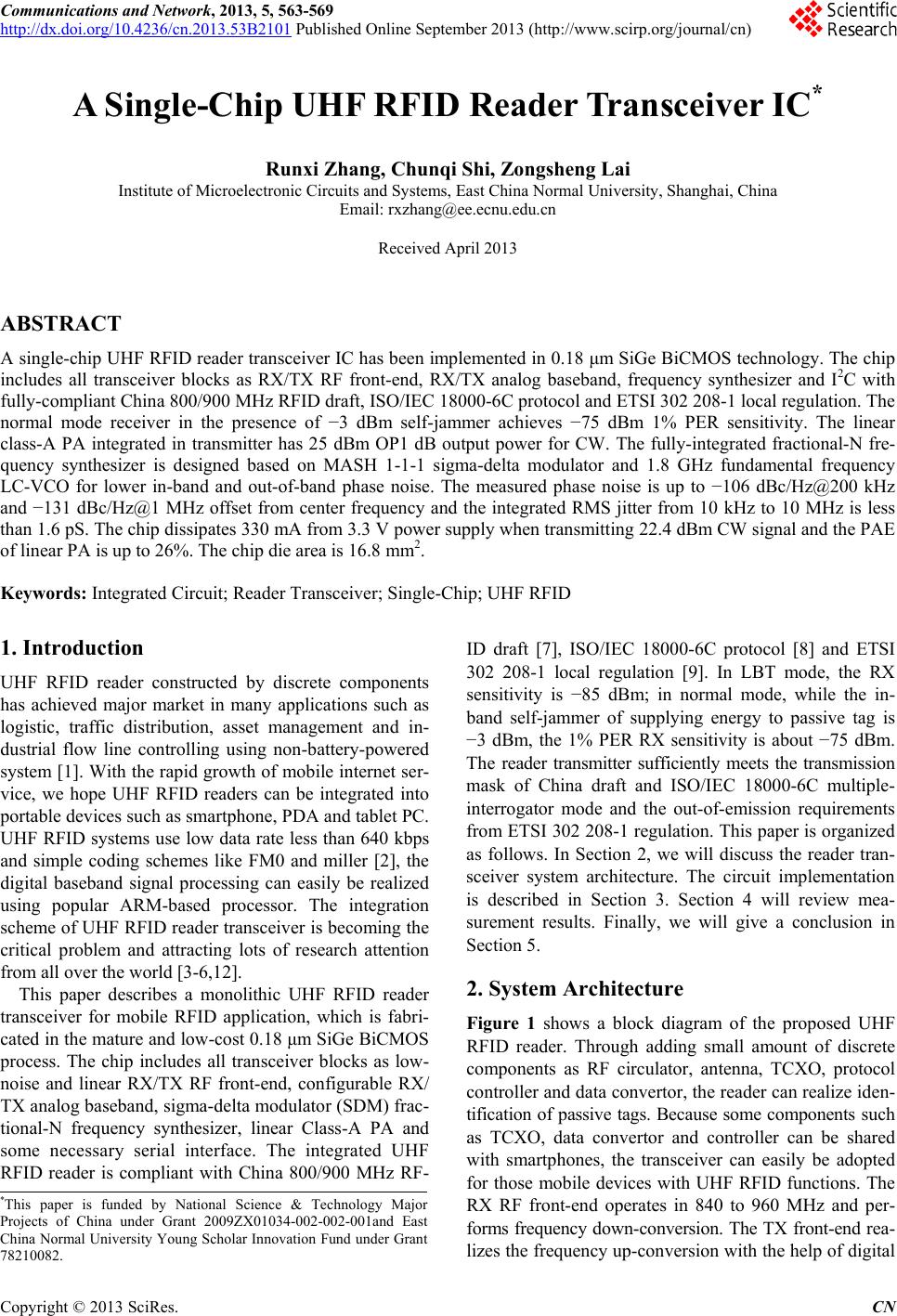
Communications and Network, 2013, 5, 563-569
http://dx.doi.org/10.4236/cn.2013.53B2101 Published Online September 2013 (http://www.scirp.org/journal/cn)
Copyright © 2013 SciRes. CN
A Single-Chip UHF RFID Reader Transceiver IC*
Runxi Zhang, Chunqi Shi, Zongsheng Lai
Institute of Microelectronic Circuits and Systems, East China Normal University, Shanghai, China
Email: rxzhang@ee.ecnu.edu.cn
Received April 2013
ABSTRACT
A single-chip UHF RFID reader transceiver IC has been implemented in 0.18 μm SiGe BiCMOS technology. The chip
includes all transceiver blocks as RX/TX RF front-end, RX/TX analog baseband, frequency synthesizer and I2C with
fully-compliant China 800/900 MHz RFID draft, ISO/IEC 18000-6C protocol and ETSI 302 208-1 local regulation. The
normal mode receiver in the presence of −3 dBm self-jammer achieves −75 dBm 1% PER sensitivity. The linear
class-A PA integrated in transmitter has 25 dBm OP1 dB output power for CW. The fully-integrated fractional-N fre-
quency synthesizer is designed based on MASH 1-1-1 sigma-delta modulator and 1.8 GHz fundamental frequency
LC-VCO for lower in-band and out-of-band phase noise. The measured phase noise is up to −106 dBc/Hz@200 kHz
and −131 dBc/Hz@1 MHz offset from center frequency and the integrated RMS jitter from 10 kHz to 10 MHz is less
than 1.6 pS. The chip dissipates 330 mA from 3.3 V power supply when transmitting 22.4 dBm CW signal and the PAE
of linear PA is up to 26%. The chip die area is 16.8 mm2.
Keywords: Integrated Circuit; Reader Transceiver; Single-Chip; UHF RFID
1. Introduction
UHF RFID reader constructed by discrete components
has achieved major market in many applications such as
logistic, traffic distribution, asset management and in-
dustrial flow line controlling using non-battery-powered
system [1]. With the rapid growth of mobile internet ser-
vice, we hope UHF RFID readers can be integrated into
portable devices such as smartphone, PDA and tablet PC.
UHF RFID systems use low data rate less than 640 kbps
and simple coding schemes like FM0 and miller [2], the
digital baseband signal processing can easily be realized
using popular ARM-based processor. The integration
scheme of UHF RFID reader transceiver is becoming the
critical problem and attracting lots of research attention
from all over the world [3-6,12].
This paper describes a monolithic UHF RFID reader
transceiver for mobile RFID application, which is fabri-
cated in the mature and low-cost 0.18 μm SiGe BiCMOS
process. The chip includes all transceiver blocks as low-
noise and linear RX/TX RF front-end, configurable RX/
TX analog baseband, sigma-delta modulator (SDM) frac-
tional-N frequency synthesizer, linear Class-A PA and
some necessary serial interface. The integrated UHF
RFID reader is compliant with China 800/900 MHz RF-
ID draft [7], ISO/IEC 18000-6C protocol [8] and ETSI
302 208-1 local regulation [9]. In LBT mode, the RX
sensitivity is −85 dBm; in normal mode, while the in-
band self-jammer of supplying energy to passive tag is
−3 dBm, the 1% PER RX sensitivity is about −75 dBm.
The reader transmitter sufficiently meets the transmission
mask of China draft and ISO/IEC 18000-6C multiple-
interrogator mode and the out-of-emission requirements
from ETSI 302 208-1 regulation. This paper is organized
as follows. In Section 2, we will discuss the reader tran-
sceiver system architecture. The circuit implementation
is described in Section 3. Section 4 will review mea-
surement results. Finally, we will give a conclusion in
Section 5.
2. System Architecture
Figure 1 shows a block diagram of the proposed UHF
RFID reader. Through adding small amount of discrete
components as RF circulator, antenna, TCXO, protocol
controller and data convertor, the reader can realize iden-
tification of passive tags. Because some components such
as TCXO, data convertor and controller can be shared
with smartphones, the transceiver can easily be adopted
for those mobile devices with UHF RFID functions. The
RX RF front-end operates in 840 to 960 MHz and per-
forms frequency down-conversion. The TX front-end rea-
lizes the frequency up-conversion with the help of digital
*
This paper is funded by National Science & Technology Major
Projects of China under Grant 2009ZX01034-002-002-
001and East
China Normal University Young Scholar Inn ovation Fund under Grant
78210082.